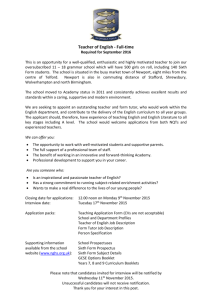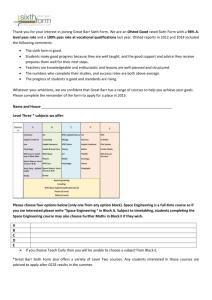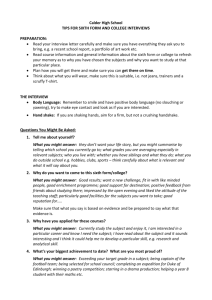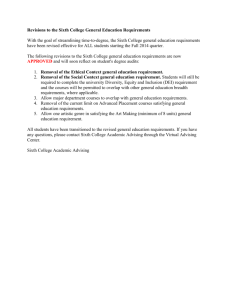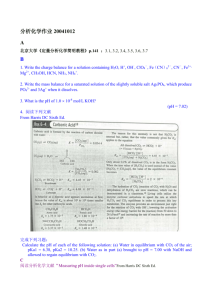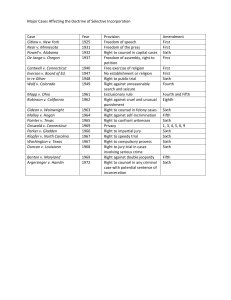multiple-alternative selection structures
advertisement
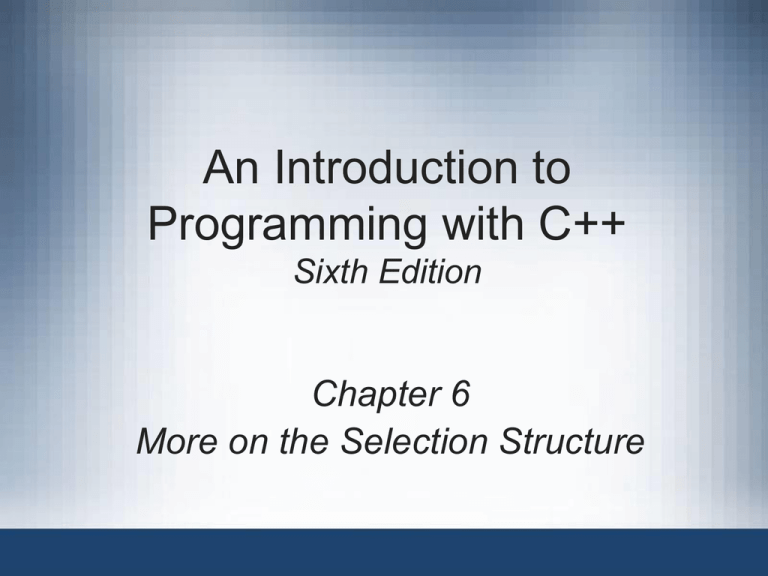
An Introduction to Programming with C++ Sixth Edition Chapter 6 More on the Selection Structure Objectives • Include a nested selection structure in pseudocode and in a flowchart • Code a nested selection structure • Recognize common logic errors in selection structures • Include a multiple-alternative selection structure in pseudocode and in a flowchart • Code a multiple-alternative selection structure in C++ An Introduction to Programming with C++, Sixth Edition 2 Making Decisions • True and false paths of a selection structure can contain other selection structures • Inner selection structures are referred to as nested selection structures; contained (nested) within an outer selection structure • Nested selection structures are used when more than one decision needs to be made before choosing an instruction • Inner (nested) selection structures are indented within their outer selection structures An Introduction to Programming with C++, Sixth Edition 3 Figure 6-1 A problem that requires a dual-alternative selection structure An Introduction to Programming with C++, Sixth Edition 4 Making Decisions (cont’d.) Figure 6-2 A problem that requires a nested single-alternative selection structure An Introduction to Programming with C++, Sixth Edition 5 Making Decisions (cont’d.) Figure 6-3 Another problem that requires a dual-alternative selection structure An Introduction to Programming with C++, Sixth Edition 6 Making Decisions (cont’d.) Figure 6-4 A problem that requires a nested dual-alternative selection structure An Introduction to Programming with C++, Sixth Edition 7 Flowcharting a Nested Selection Structure • Outer and inner selection structures can be thought of as making primary and secondary decisions, respectively • Secondary decision is called such because whether it needs to be made depends on the result of a primary decision An Introduction to Programming with C++, Sixth Edition 8 Flowcharting a Nested Selection Structure (cont’d.) Figure 6-5 Problem specification for voter eligibility problem An Introduction to Programming with C++, Sixth Edition 9 Figure 6-5 A correct solution to the voter eligibility problem An Introduction to Programming with C++, Sixth Edition 10 Figure 6-6 Another correct solution to the voter eligibility problem An Introduction to Programming with C++, Sixth Edition 11 Coding a Nested Selection Structure • Code for nested selection structures uses the if and else statements • Nested selection structures can be placed in either if or else statement blocks • Correct tabbing makes code easier to read An Introduction to Programming with C++, Sixth Edition 12 Coding a Nested Selection Structure (cont’d.) Figure 6-7 Modified problem specification for the health club problem from Chapter 5’s Lab 5-2 An Introduction to Programming with C++, Sixth Edition 13 Figure 6-7 Modified program for the health club problem from Chapter 5’s Lab 5-2 An Introduction to Programming with C++, Sixth Edition 14 Figure 6-7 Modified program for the health club problem from Chapter 5’s Lab 5-2 (cont’d.) An Introduction to Programming with C++, Sixth Edition 15 Coding a Nested Selection Structure (cont’d.) Figure 6-8 Sample run of the modified health club program An Introduction to Programming with C++, Sixth Edition 16 Logic Errors in Selection Structures • Three common logic errors made when writing selection structures – Using a compound condition rather than a nested selection structure – Reversing the outer and nested decisions – Using an unnecessary nested selection structure An Introduction to Programming with C++, Sixth Edition 17 Logic Errors in Selection Structures (cont’d.) Figure 6-9 A correct algorithm for the bonus problem An Introduction to Programming with C++, Sixth Edition 18 Logic Errors in Selection Structures (cont’d.) Figure 6-10 Test data and manually calculated results Figure 6-11 Current status of the desk-check table Figure 6-12 Desk-check table after completing the first desk-check An Introduction to Programming with C++, Sixth Edition 19 Logic Errors in Selection Structures (cont’d.) Figure 6-13 Desk-check table after completing the second desk-check Figure 6-14 Desk-check table after completing the third desk-check An Introduction to Programming with C++, Sixth Edition 20 First Logic Error • Using a compound condition rather than a nested selection structure • Ignores the hierarchy between two sub-conditions – One applies only if the other is a certain value An Introduction to Programming with C++, Sixth Edition 21 First Logic Error (cont’d.) Figure 6-15 Correct algorithm and an incorrect algorithm containing the first logic error An Introduction to Programming with C++, Sixth Edition 22 First Logic Error (cont’d.) Figure 6-16 Desk-check table for the incorrect algorithm in Figure 6-15 An Introduction to Programming with C++, Sixth Edition 23 Second Logic Error • Reversing the outer and nested selection structures Figure 6-17 Correct algorithm and an incorrect algorithm containing the second logic error An Introduction to Programming with C++, Sixth Edition 24 Second Logic Error (cont’d.) Figure 6-18 Desk-check table for the incorrect algorithm in Figure 6-17 An Introduction to Programming with C++, Sixth Edition 25 Third Logic Error • Using an unnecessary nested selection structure • Often will produce the correct result, but will be inefficient An Introduction to Programming with C++, Sixth Edition 26 Third Logic Error (cont’d.) Figure 6-19 Correct algorithm and an incorrect algorithm containing the third logic error An Introduction to Programming with C++, Sixth Edition 27 Third Logic Error (cont’d.) Figure 6-20 Desk-check table for the inefficient algorithm in Figure 6-19 An Introduction to Programming with C++, Sixth Edition 28 Multiple-Alternative Selection Structures • Sometimes problems require a selection structure that chooses between several alternatives • Called multiple-alternative selection structures or extended selection structures • In a flowchart, diamond symbol is used; has multiple flowlines leading out, not just two • Each flowline represents a possible path, marked with the value that represents that path • if/else statements can be used to implement it; uses multiple if else clauses An Introduction to Programming with C++, Sixth Edition 29 Multiple-Alternative Selection Structures (cont’d.) Figure 6-21 Problem specification for the Kindlon High School problem An Introduction to Programming with C++, Sixth Edition 30 Multiple-Alternative Selection Structures (cont’d.) Figure 6-21 IPO chart for the Kindlon High School problem An Introduction to Programming with C++, Sixth Edition 31 Multiple-Alternative Selection Structures (cont’d.) Figure 6-22 Flowchart for the Kindlon High School problem An Introduction to Programming with C++, Sixth Edition 32 Figure 6-23 One version of the C++ code for the Kindlon High School problem An Introduction to Programming with C++, Sixth Edition 33 Figure 6-23 Another version of the C++ code for the Kindlon High School problem An Introduction to Programming with C++, Sixth Edition 34 The switch Statement • Can sometimes use the switch statement to code a multiple-alternative selection structure • Statement begins with switch keyword followed by a selector expression in parentheses • Selector expression can contain any combination of variables, constants, functions, and operators • Must result in a data type that is bool, char, short, int, or long • Between opening and closing braces (after selector expression), there are one or more case clauses An Introduction to Programming with C++, Sixth Edition 35 The switch Statement (cont’d.) • Each case clause represents a different alternative and contains a value followed by a colon • Can include as many case clauses as necessary • Value for each case clause can be a literal constant, named constant, or an expression composed of literal and named constants • Data type of the value should be the same data type as the selector expression An Introduction to Programming with C++, Sixth Edition 36 The switch Statement (cont’d.) • Each case clause contains one or more statements processed when selector expression matches that case’s value • break statement tells computer to break out of switch at that point; must be the last statement of a case clause • Without a break statement, computer continues to process instructions in later case clauses • After processing break, computer processes next instruction after switch statement’s closing brace An Introduction to Programming with C++, Sixth Edition 37 The switch Statement (cont’d.) • Good programming practice to document end of switch with a comment (//end switch) • Can also include one default clause; processed if selector expression does not match any values in case clauses • default clause can appear anywhere, but usually entered as last clause – If it is the last clause, a break statement is not needed at its end – Otherwise, a break statement is needed to prevent computer from processing later case clauses An Introduction to Programming with C++, Sixth Edition 38 The switch Statement (cont’d.) Figure 6-24 How to use the switch statement An Introduction to Programming with C++, Sixth Edition 39 Figure 6-24 How to use the switch statement (cont’d.) An Introduction to Programming with C++, Sixth Edition 40 The switch Statement (cont’d.) Figure 6-25 Problem specification for the Warren Company problem An Introduction to Programming with C++, Sixth Edition 41 Figure 6-25 IPO chart and C++ instructions for the Warren Company problem An Introduction to Programming with C++, Sixth Edition 42 Summary • Can nest a selection structure within true or false path of another selection structure • Three common logic errors when writing selection structures – Using a compound condition instead of a nested selection structure – Reversing the inner and outer selection structures – Using an unnecessary nested selection structure An Introduction to Programming with C++, Sixth Edition 43 Summary (cont’d.) • Some solutions require selection structures that choose from multiple alternatives; called multiplealternative or extended selection structures • Can code these either with if else statements or the switch statement • Diamond is used to represent multiple-alternative selection structures in a flowchart • Has multiple flowlines leading out; each representing a possible path and marked with appropriate values An Introduction to Programming with C++, Sixth Edition 44 Summary (cont’d.) • In a switch statement, the data type of the value in each case clause must be compatible with data type of selector expression • Selector expression much evaluate to value of type bool, char, short, int, or long • Most case clauses contain a break statement; tells the computer to leave the switch statement • Good practice to mark end of switch statement with a comment (//end switch) An Introduction to Programming with C++, Sixth Edition 45 Figure 6-26 Flowchart for Lab 6-1 An Introduction to Programming with C++, Sixth Edition 46 Lab 6-2: Plan and Create Figure 6-27 Problem specification for Lab 6-2 An Introduction to Programming with C++, Sixth Edition 47 Lab 6-3: Modify • Modify the program in Lab 6-2 to calculate commission based on information in Figure 6-33 Figure 6-33 Problem specification for Lab 6-3 • If the sales are less than zero, display “The sales cannot be less than zero.” • If the code is not 1, 2, or 3, display “Invalid Code” An Introduction to Programming with C++, Sixth Edition 48 Figure 6-34 Code for Lab 6-4 An Introduction to Programming with C++, Sixth Edition 49 Lab 6-5: Debug • Follow the instructions for starting C++ and opening the Lab6-5.cpp file • Test the program using codes 1, 2, 3, 4, 5, 9, and -3 • Debug the program An Introduction to Programming with C++, Sixth Edition 50
